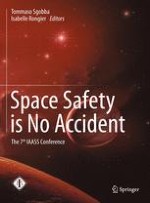2015 | OriginalPaper | Chapter
Columbus ECLSS and TCS Safety and Reliability Considerations for ISS Life Time Extension
Authors : Alessandro Nocera, Laura Garbellini, Alexander Getimis, Piera Mannini
Published in: Space Safety is No Accident
Publisher: Springer International Publishing
Activate our intelligent search to find suitable subject content or patents.
Select sections of text to find matching patents with Artificial Intelligence. powered by
Select sections of text to find additional relevant content using AI-assisted search. powered by
